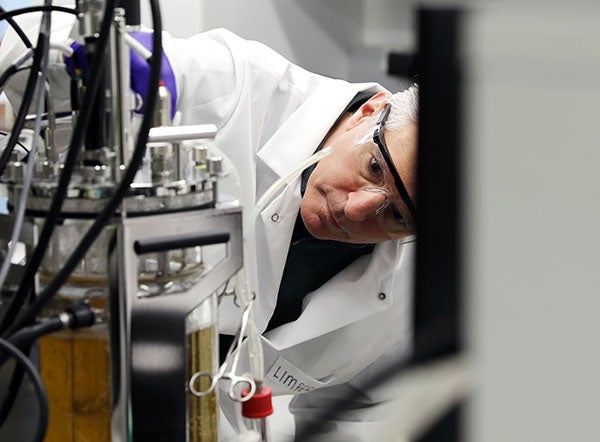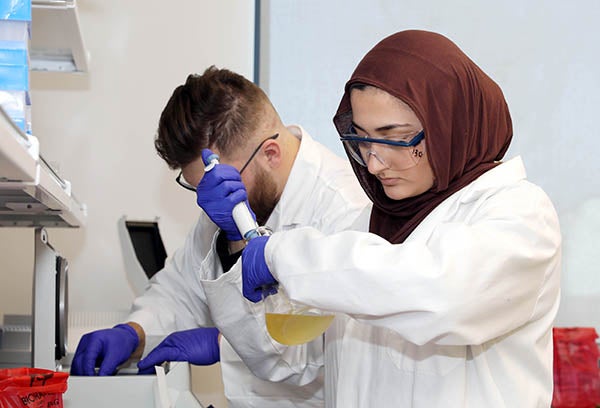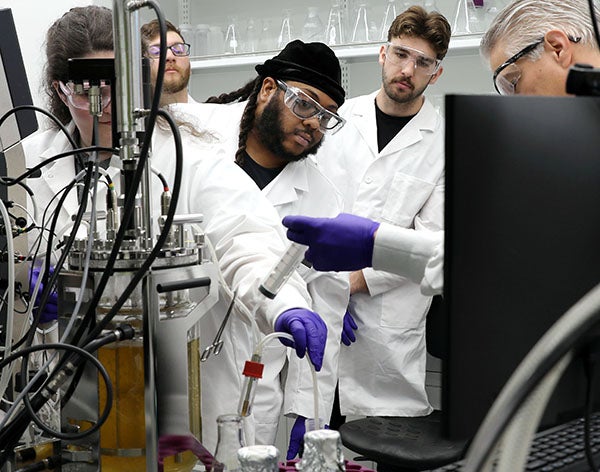New Bioreactors Boost Careers
Students get hands-on experience in biomanufacturing with new equipment
The job market in the pharmaceutical industry is growing — just like the cells in the new bioreactors at East Carolina University’s Eastern Region Pharma Center.

Dr. Loren Limberis, engineering associate professor and director of the Eastern Region Pharma Center, works with a new bioreactor.
Engineering students put the new Sartorius bioreactors to good use with a 24-hour lab in the Life Sciences and Biotechnology Building, collecting data on cell growth once each hour.
“This is the first time we’re using these new bioreactors,” said Dr. Loren Limberis, associate professor of engineering and the director of the pharma center.
He said the new reactors allow the students to see their work in action, in the case of this lab, a golden liquid with air bubbles flowing from bottom to top. The bioreactors monitor factors that can influence cell growth such as temperature, pH levels, dissolved oxygen and even the rate at which the liquid is stirred. The bioreactors — funded as part of the Golden LEAF Foundation’s initial $1.9 million grant in support of the pharmer center — can automatically adjust those features for optimum cell growth.
Limberis compared it to the cruise control on a vehicle going up a hill. To maintain speed, the car’s engine automatically adjusts.
Readings on the machine provide the information, but a glance at the liquid in the container also offers clues as to what’s happening. As an example, the size of the bubbles in the liquid can indicate the amount of oxygen. Older bioreactors had only a narrow slit in which students could visually observe the liquid.
“These new units allow for the students to acquire data from the bioreactors, store it and analyze it,” Limberis said. “They also allow students to log into the bioreactor control unit and monitor the conditions remotely and to be able to change or adjust the conditions remotely.”
Work with a Purpose
The bioreactors offer a glimpse of what students will find working in the pharmaceutical industry.
“It gives them the hands-on experience of starting from a colony on a petri dish and propagating the growth of the cells to the point where they can put it in a bioreactor in which they can control all of the growth parameters as they learn how to optimize productivity out of the cells,” Limberis said. “These units allow them to understand how a bench scale bioreactor works, how to program it and how to monitor it, which helps them analyze the data at the end of the run.”
He said the lab provides students in engineering — and others who can take the course as a technical elective — the fundamentals of biomanufacturing.

Nema Salaheldeen, a junior engineering and chemistry major from Greenville, works during the lab.
“They get the hands-on experience of upstream and downstream biomanufacturing of an enzyme,” Limberis said. “This provides them the fundamentals of being able to work in the pharma industry with a concentration in electrical engineering or mechanical engineering or environmental engineering, not necessarily biochemical engineering. Pharma industry demand for engineers is high, and if they have this hands-on laboratory background experience of the entire biomanufacturing process, they are more competitive in the job market.”
According to Data USA, job growth in pharmaceutical manufacturing is projected at 5.45% over the next 10 years, with an average annual salary of $124,908.
Nema Salaheldeen is a junior majoring in engineering with a concentration in biochemical engineering. She’s also a chemistry major.
“I am still deciding on if I want to go into industry or pursue a master’s degree,” she said. “Hopefully I’ll have it figured out by next semester. I’m most likely going into industry, and hopefully I’ll work with a pharmaceutical company, working on a new drug.”
Dressed in a white lab coat and wearing goggles, Salaheldeen helped collect the first sample in the first hour from the bioreactor. She said the biochemical engineering concentration is exactly what she was looking for when she came to ECU.
“I’m really interested in chemistry, and when I heard about this concentration, I just had to do it,” she said. “I really like how versatile the field is. I could work in pharmaceuticals. I could work in research. I’m working with Dr. (Kura) Duba right now converting frying oil into biodiesel, so that works in the field right now too.”
Inside the Lab
During the lab, students worked in shifts to monitor the bioreactors and take samples.

Engineering students watch as a sample is taken from the new Sartorius bioreactor.
“The bioreactors are used to grow genetically modified E. coli cells, and these E. coli cells produce the bioluminescent enzyme firefly luciferase,” Limberis said. “It’s the enzyme that creates that greenish yellow glow from fireflies, so the students are using that as a model to see how they can optimize their culture conditions to optimize the production of the enzyme. One way they can measure that is to measure how much bioluminescent activity the samples have. The more bioluminescent activity the samples have, the more stable of an active protein there is.
“At the end, they’ll analyze the data to see how well the cells grew and proportionally how much protein was produced based on bioluminescent activity.”
Limberis said the lab tests the students in methods they could see in pharmaceutical careers.
“We use firefly luciferase as a model protein because it is unstable,” he said. “It does require careful handling, which challenges the students with the conditions they would see in the industry.”
A week after the 24-hour lab session, the students returned to analyze the data and prepare reports on what they discovered.
“The overall goal is to use these bioreactors and compare them to different culture conditions to see what parameters they can adjust toward optimization of firefly luciferase production,” Limberis said.
The lab is part of the Fundamentals of Biomanufacturing course in the Department of Engineering.
The Eastern Region Pharma Center, housed in ECU’s Life Sciences and Biotechnology Building, is a leader in workforce development for the pharmaceutical industry. Working with pharmaceutical companies and regional community colleges, the center aims to provide new workers for the industry and provide training to current pharmaceutical employees.
